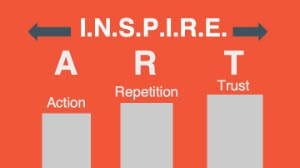Your Team Yearns For Better Performance Feedback
If you knew your manager really cared about you, would you want them to give you meaningful performance feedback?
Even if it was hard to hear?
Every time we ask these questions in our leadership development programs, the answer is always a resounding “YES!”
Most employees yearn for more meaningful performance feedback—and are just not getting enough.
5 Steps to Meaningful Performance Feedback
Today we share 5 steps to more meaningful performance feedback.

Karin Hurt explans the Let’s Grow Leaders INSPIRE method for accountability conversations
1. Set clear expectations
Communicate What Success Looks Like
When performance feedback conversations don’t work, one of the biggest reasons is a lack of shared expectations.
For example, you might be frustrated that your direct report isn’t keeping you in the loop.
But before you jump into structured performance feedback, ask yourself “Did I set a clear expectation of what topics I need to be made aware of and what success looks like (e.g. I’ll never be blindsided?)”
We find many managers need to reset expectations before it’s fair to begin a feedback conversation.
Be sure you have a shared expectation of what success looks like.
2. Check for understanding
Confirm Shared Expectations
Of course, setting clear expectations is not enough. You need to check to ensure they got it.
That’s where the check for understanding comes in. You want to check for understanding in two areas: actions and emotions.
Check for Understanding #1: Actions
The action-focused check for understanding ensures a mutually shared understanding of the activity. It looks like this:
“Let’s do a quick check for understanding—what’s the first thing we’re going to do as we leave this meeting?”
The idea is to have your team tell you what they think they’ve heard so everyone is confident that they understand what happens next.
Check for Understanding #2: Emotions
The emotion-focused check for understanding gives your team a chance to process what’s happening and surface any issues that might arise. It looks like this:
Leader: “Great meeting. I’m super excited about this strategy. Before we end, I’d like to ask, ‘How are you feeling?’”
Team member 1: “Well, I’m excited about it too, but I’m also worried about how we will do this considering our other priorities.”
Team member 2: “I’m feeling overwhelmed. These are wonderful ideas and I really want to do them, but I don’t know where to begin.”
If people have concerns like this, it’s better to know before they leave the meeting so you can help your team move through them, adjust expectations, or remove roadblocks.
3. Plan a two-way conversation
The Let’s Grow Leaders INSPIRE Method for Meaningful Performance Feedback
As we wrote in Fast Company, every good feedback conversation accomplishes three goals.
- Set an INTENTION and provide specific examples
- Create a two-way CONVERSATION
- Invite a COMMITMENT and recap the conversation
Our Let’s Grow Leaders INSPIRE Method makes this conversation both natural and effective.
(And it’s WAY BETTER than the “Sandwich Feedback” technique)
I- Initiate
Initiate the conversation respectfully.
This could be something as simple as, “I need to talk to you today. Is this a convenient time?”
Or, if you have a more sensitive or serious conversation in mind, you may say something like, “I really care about you and your career and I want you to be successful. I have an observation. Do you have some time later today to talk?”
N- Notice
Share your concern or observation.
We’re very deliberate in using the word “notice” because you can notice a behavior, but you can’t notice an attitude.
For example, “I noticed that when your peers offered suggestions in the last meeting, you interrupted them before they could finish and told them why their idea wouldn’t work.”
When you think about describing behavior that feels like a bad attitude, it can help to imagine recording what’s happening on your phone, playing back the recording, and describing what you observe. (Of course, don’t actually do this).
But what would you see if you did? Describe those behaviors.
S- Support
Provide supporting evidence.
“When Laura shared her idea about the new campaign, you interrupted her before she could finish, raised your voice, and told her the idea was stupid.” And when Joe talked about his new approach to customer visits, you laughed out loud and told him “that’s a rookie move.”
P- Probe
The real magic of the INSPIRE method is in the Probe and Invite steps. This is where you ask open-ended questions to encourage them to reflect on the behavior that you’re looking to change.
It could be something as simple as, “What’s going on?” Or, “Why do you think this keeps happening?”
I-Invite
And then, in the Invite stage, you ask them to come up with ideas to improve. “What do you think you could do to ensure that our next meeting goes more smoothly?” “What do you think you can do to be more respectful to your peers in the next meeting?”
R- Review
Here’s where you recap their commitment. This is a check for understanding. “Great, so what I hear you’re going to do is to ensure you let your peers finish their ideas and really consider them before offering your opinion.”
E- Enforce
In this final step of the INSPIRE method, you schedule a check-in on progress. “So we have two more staff meetings this month, let’s schedule time on the 30th at 3pm to talk about how these meetings are going.”
You may feel tempted to skip this step. But it’s important for two reasons. First, if they know they are going to talk with you about this again (and have that meeting on their calendar), they’re more likely to pay attention to their behavior. Second, if they improved, you want to recognize that. And if not, it’s important to have that conversation too (we share more about what to do if the behavior continues later in the article).
When a behavior doesn’t change, it’s often because the feedback is too vague or the conversation goes too long and the employee forgets what they need to do. Work to INSPIRE specific behavior change by using this simple technique.
Summary of the Let’s Grow Leaders INSPIRE Method
- Initiate the conversation.
- Notice a specific behavior.
- Support with objective evidence.
- Probe by asking about their perspective.
- Invite solutions.
- Review with a check for understanding.
- Enforce by scheduling a mutual follow-up.
4. Escalate the conversation as needed.
The Let’s Grow Leaders A.R.T. Method of Advanced Accountability
Of course, sometimes one conversation isn’t enough.
If you set clear performance expectations, checked for understanding, and addressed issues as they arise through INSPIRE conversations, you’re likely seeing a significant improvement in employee performance.
But, we all know that sometimes one conversation isn’t enough. That’s when you need to escalate the conversation using the A.R.T. Method of Advanced Accountability. The A.R.T. Method helps you escalate the conversation in a way that continues to build the relationship while striving for results.
Each stop of the A.R.T. Method continues to use the INSPIRE Method. But as you move through the three stages of the method, your N – Notice step changes. You will Notice different behaviors at each stage. Here’s how it works:
A – Action
You’ve already learned how to have an A – Action conversation. This is the INSPIRE method we’ve just described. Most feedback conversations start by discussing a specific action. For example, a person showed up to the meeting late. They didn’t document their account. Or they interrupted a colleague and negated their ideas. These are actions.
Your first one or two INSPIRE conversations focus on that specific behavior using the method described above.

R – Repetition
However, if you’ve had two Action conversations and it happens again, it’s time to move to R-Repetition. This time, you will once again have an INSPIRE conversation, but instead of focusing on their Action (eg: being late), you will notice the repeated behavior. You are calling attention to the repetition or pattern. For example, “I’ve noticed a small pattern where you’re arriving late.”
Then you would move to the S-Support step and share the specific examples, “It was 10:15 this morning, 9:30 last Monday, and 9:45 the Friday before.”
Sometimes people aren’t aware they have a pattern of behavior. When you address the repetition and provide specific examples, you’ve escalated the conversation, put it on a more serious footing, and, often, helped someone identify an issue they had minimized or of which they were unaware.
Note: you would only move to a Repetition conversation if the behavior repeats in a short amount of time. For example, if they were late once in each of the past two years, that’s not a pattern. But arriving late one day in each of the past three weeks would definitely warrant a Repetition conversation.
So you’ve noticed the repeated behavior and provided supporting examples. Next, when you get the R-Review step of the INSPIRE Method for a Repetition conversation, you will change the check for understanding to include a commitment. For example, “I’m hearing that you’re going to document the CRM and that the way you’ll do that is by setting an appointment for yourself on Friday afternoons. Is that a commitment you can make?”
Using the word “commitment” mirrors the more serious nature of a repeated pattern of behavior. Their commitment also lays the groundwork for the next conversation, should the behavior continue.

T – Trust
When you’ve had a recent R-Repetition conversation and the negative behavior happens again, you will need to escalate the conversation once more.
You will once again have an INSPIRE conversation, but you won’t focus on being late or documenting the account. This time your N-Notice step will focus on the person not keeping their commitment. Here’s what it looks like:
“Do you remember the conversation we had last week about documenting the CRM? Yeah, do you remember the commitment you made last Friday? So here’s the thing. I noticed that this week, you didn’t keep your word, and I’m concerned. Listen, I want to be able to trust you. I know you want to be able to trust me as your leader, as your manager. You’ve got to be able to take my word and bank on it. And I want to have that same relationship with you. Right now, that’s not happening. I want to see you succeed. I want the best for you. It’s important that you achieve all of your goals here, and this is going to prevent that. So what’s happening here? How do you think we can fix it?”

Trust Conversation Outcomes
When you use that final T-Trust conversation, one of three things can happen:
1. The first option is that people turn the corner. All of us need a trust conversation at some point – it’s part of the human experience. We turn the corner and move forward because we don’t want to be hypocrites. Eg: “Oh my gosh, I never thought about this in terms of I didn’t keep my word” and we make the change.
2. The second option is that the people remove themselves from the role. They will say something like, “You’re right. You know what? I’ve been thinking about it and this isn’t the right role for me.” And that may not feel great, but it is a victory. There’s no point keeping somebody suffering in a role that’s not a good match. It drops their productivity. Your team’s not producing the way you need them to. It’s better if they can have that realization.
3. The third option that can happen is people say they’ll make the change and they don’t. But now you’ve gone through a whole series of conversations and you know this isn’t the right role for them. It makes it much easier to make those transitions, to help them find something else, either in the organization or out of the organization.
Choose Your Emotion
When you have these A.R.T. performance feedback conversations, your emotional tone plays a vital role. We recommend a quiet, serious, concerned, even disappointed tone in these conversations. When you approach the other person with empathy and concern for their success, it increases the chance that they will reflect on their behavior and make a healthier choice.
In contrast, when you vent your anger on someone, it’s more likely that they will focus on you and silently ask, “Why are they being such a jerk?” rather than focus on their own behavior.
Please note that we’re not saying you shouldn’t be angry—anger is a valuable human emotion. Rather, choosing to have your conversation from a place of concern for the other person gives you the best chance of building the relationship and achieving results.
It’s unlikely they will tell themselves, “My boss is concerned about my career —why are they being such a jerk?” Even if they’re upset about the situation, they’re more likely to focus on their own behavior and needs.
Summary of the Let’s Grow Leaders A.R.T. Method For Advanced Accountability
- Action conversation – focus on the specific behavior
- Repetition conversation – focus on the repeated pattern of behavior
- Trust conversation – focus on the broken commitment and relationship
A.R.T. and Your HR Partners
As you consider the A.R.T. process, collaborate and connect with your HR business partners. The A.R.T. method syncs up well with most performance feedback processes. Talk with your Human Resource professional to ensure you understand and follow your internal procedures. Document all your performance conversations. When you need to have a Repetition conversation, let your HR partner know. And before you have the Trust conversation, talk with your HR partner. They’ll have advice for you or may want to attend the conversation and can help emphasize what needs to happen.
One final thought: the A.R.T. method for escalating performance feedback conversations is appropriate for the lower-level types of behaviors that are irritating, relevant to the work, but easily corrected. You would not use the A.R.T. method when someone steals proprietary information or assaults a colleague.
5. Speak with Candor
Avoid This Tempting Mistake When Giving Performance Feedback
If you’ve heard one of our keynotes or seen us racing through an airport with a Diaper Genie tucked under our arms as we were racing through security, you know about Diaper Genie Feeback. The I.N.S.P.I.R.E. method is a practice way to prevent this common mistake of covering up the real message. More here.
Other Articles on Giving Performance Feedback You May Find Useful
How to Lead a Performance Conversation Without Losing Your Cool
Avoid These Infuriating Phrases When Giving End of Year Feedback
How to Hold a Better Performance Improvement Conversation
How to Establish Team Accountability if You Never Have Before
Leadership Skills: 6 Competencies You Can’t Lead Without
Looking for more ways to coach your employees to high-performance? We can help.
Learn more about our leadership development programs.
Or contact us at info@letsgrowleaders.com 443-750-1249







I appreciate these ideas, but I’d love to hear more on how to do this when you are the employee needing to communicate feedback to your supervisor
Hi Tanya, This is a fantastic question and one that comes up frequently in our leadership development programs. And, I went to see if we have ever have written an article to answer this question (and although we do it in real-time all the time, ironically we have not).
So thanks for the “Asking For a Friend” blog post idea, and I will include a link to a longer answer once I write it 😉
For now, the INSPIRE method works very well in all directions (even with your boss), but it’s important to make some adjustments.
First, as with all feedback conversations, ground yourself and really think this through. If you come from a place of frustration or anger, you might find your manager becomes defensive.
Next, how you I-Initiate the conversation matters a lot.
“I really care about you, this team, and our success, and I have an observation that might be helpful. Would you be interested in hearing that?”
(Note: If you start the feedback conversation in that way, your manager is much more likely to be open to the feedback. I’m consistently asking groups of managers “if you knew someone truly cared about you and your career, would you want them to tell you the truth if they had some feedback?”– the answer is always 100% yes. Most people really want to improve.)
Then do your N (Notice) and S (Support) steps.
Notice the behavior with examples.
Your P (Probe) can take on a different tenor… instead of “what’s going on?” Or, “why do you think this keeps happening?” You might try something like, “I’d love to help you with this, is there anything that I can do to support you?” Or, if you’ve noticed they’ve not met a commitment, you can follow the notice statement with, “I just want to check in with you on this to see what’s going on and how I can help.”
You can still schedule the follow-up with the E-Enforce by recapping the next steps.
I’ll be back more soon with an Asking For a Friend response 😉